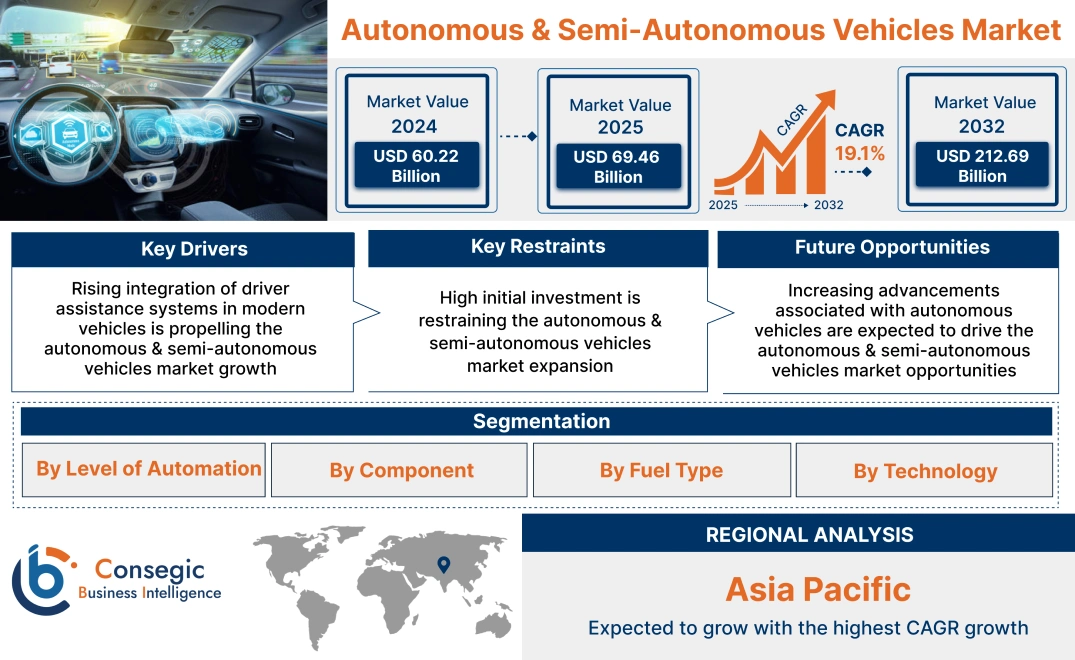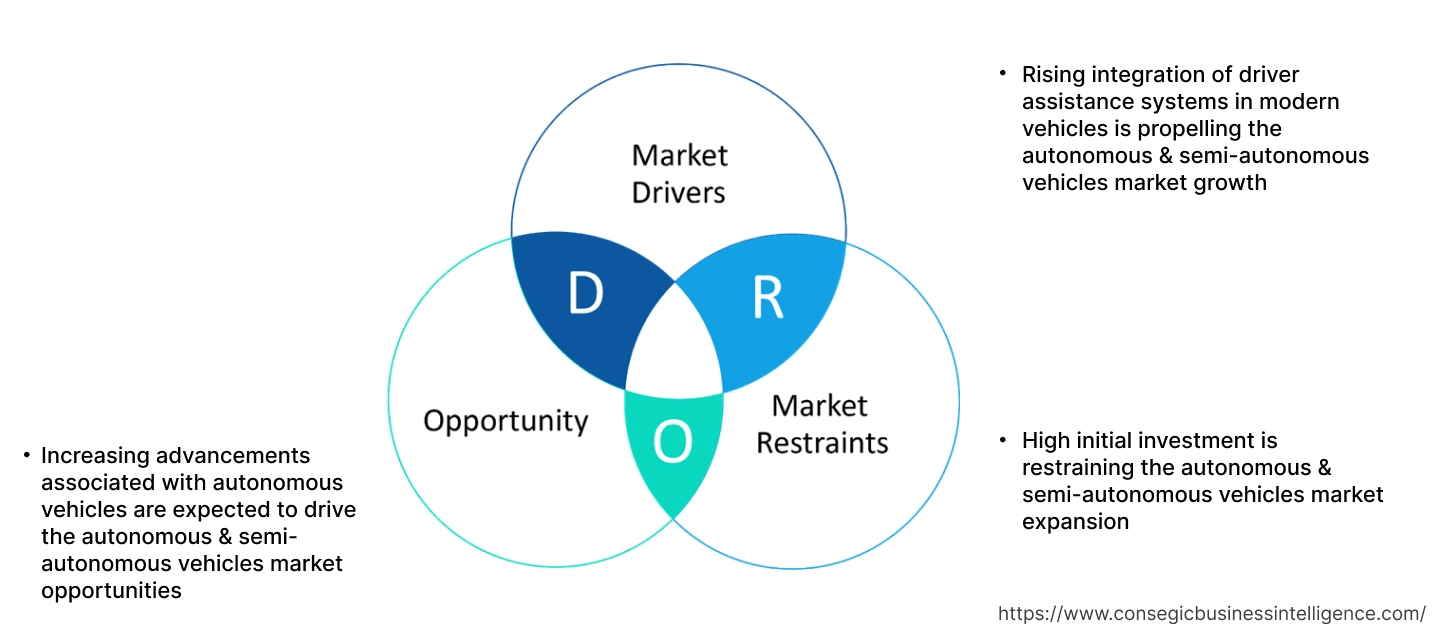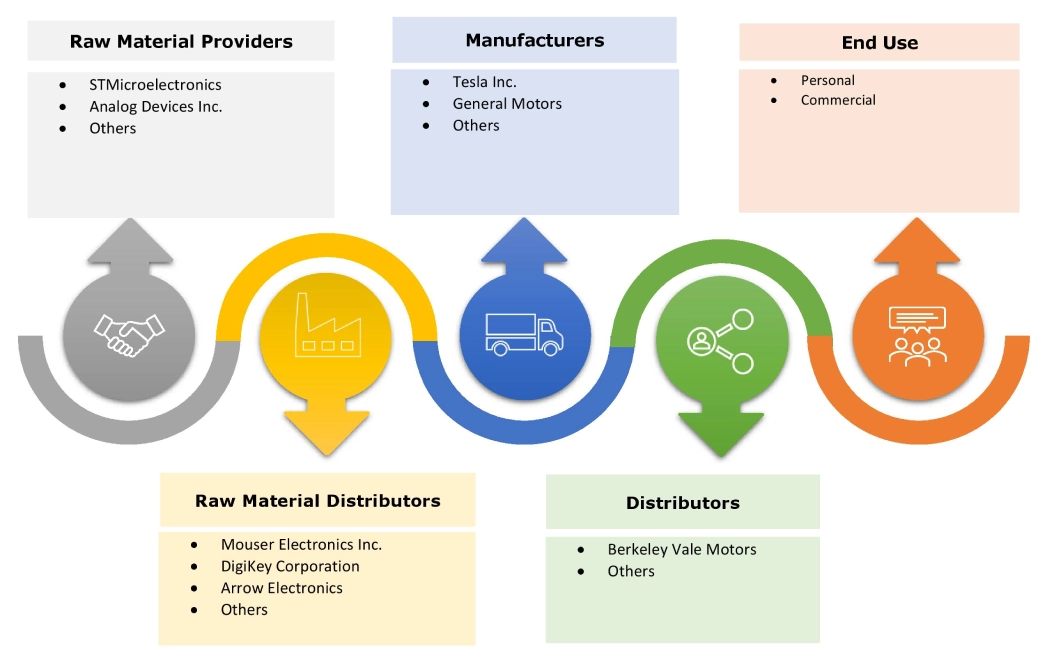- Summary
- Table Of Content
- Methodology
Autonomous & Semi-Autonomous Vehicles Market Size:
Autonomous & Semi-Autonomous Vehicles Market size is estimated to reach over USD 212.69 Billion by 2032 from a value of USD 60.22 Billion in 2024 and is projected to grow by USD 69.46 Billion in 2025, growing at a CAGR of 19.1% from 2025 to 2032.
Autonomous & Semi-Autonomous Vehicles Market Scope & Overview:
Semi-autonomous vehicles refer to vehicle that can automate certain driving tasks but still require human oversight and intervention. Semi-autonomous vehicles are capable of handling certain functions, such as lane-keeping assistance, adaptive cruise control, automated parking, collision avoidance, and others, however, the driver must remain alert, monitor the environment, and take control at any time. Meanwhile, autonomous vehicles are typically equipped with advanced technologies that enables them to navigate and operate without any human intervention. Moreover, autonomous vehicles often utilize a combination of cameras, sensors, radar, and artificial intelligence (AI) to observe their environment, make decisions, and carry out driving tasks. Autonomous & semi-autonomous vehicles are transforming the driving experience and providing a range of benefits for passengers, drivers, and automobile manufacturers.
Key Drivers:
Rising integration of driver assistance systems in modern vehicles is propelling the autonomous & semi-autonomous vehicles market growth
Advanced driver-assistance systems are primarily integrated in modern vehicles for assisting drivers with safe operation of a vehicle. Moreover, advanced driver-assistance system utilizes automated technology involving sensors and cameras for detecting nearby obstacles or driver errors, and responding accordingly to avoid an accident, which facilitates semi-autonomous vehicle operations. Additionally, the integration of advanced driver assistance systems in modern semi-autonomous vehicles facilitate several vehicle functionalities such as adaptive cruise control, intelligent park assistance, lane departure warning, blind spot detection, and automatic emergency braking among others. Further, governments worldwide are introducing favorable initiatives and regulations for installation of ADAS in modern vehicles, which are further driving the market.
- For instance, in April 2022, Honda Cars India Limited launched its new hybrid electric vehicle, Honda City eHEV. The Honda City eHEV is also integrated with ADAS technology to provide an enhanced driving experience. The ADAS system enables several features such as adaptive cruise control, lane keep assist, road departure warning, auto high beam control, and collision mitigation braking system.
Therefore, as per the analysis, the rising integration of driver assistance system in modern vehicles is proliferating the autonomous & semi-autonomous vehicles market size.
Key Restraints:
High initial investment is restraining the autonomous & semi-autonomous vehicles market expansion
High initial investment associated with the integration of autonomous & semi-autonomous vehicles technologies and system is among the key factors restraining the market. The upfront costs associated with development of autonomous & semi-autonomous vehicles including costs of hardware components, software, and others along with integrating them into vehicles can be considerably high, which may generate financial barriers, specifically for smaller businesses or businesses functioning on tighter budgets.
Furthermore, semi-autonomous & autonomous vehicle technologies and systems often require the attention of specialized technicians for repair in an event of technical issue, which could lead to increased costs and vehicle downtime. Hence, high initial investments related to semi-autonomous & autonomous vehicles are restraining the market.
Future Opportunities :
Increasing advancements associated with autonomous vehicles are expected to drive the autonomous & semi-autonomous vehicles market opportunities
Autonomous vehicles are gaining significant popularity since recent years, attributing to its ability to facilitate safer commuting, enhance driving experience, and improve traffic flow among others. Moreover, semi-autonomous & autonomous vehicle technology plays a critical role in assisting safe operation of the vehicle. As a result, the increasing advancements associated with autonomous vehicles are providing lucrative aspects for market development.
- For instance, in July 2023, Volkswagen Group commenced its first autonomous vehicle test program in Austin, United States. The program includes the rollout of a batch of 10 all-electric vehicles integrated with an autonomous driving technology platform. Volkswagen Group also intends in increasing its test fleet in Austin and expanding its testing operations to four more cities in the U.S. Additionally, the company plans to launch its autonomous driving vehicles in Austin by 2026.
Hence, the increasing advancements associated with autonomous vehicles are projected drive the autonomous & semi-autonomous vehicles market opportunities during the forecast period.
Autonomous & Semi-Autonomous Vehicles Market Segmental Analysis :
By Level of Automation:
Based on level of automation, the market is segmented into level 1, level 2, level 3, level 4, and level 5.
Trends in the level of automation:
- Rising trend in adoption of level 2 autonomy in vehicles for facilitating partial driving automation.
- Increasing technological advancements associated with level 4 and level 5 autonomy for facilitating complete automation of vehicles.
The level 2 segment accounted for a significant revenue in the overall market in 2024, and it is anticipated to register a substantial CAGR growth during the forecast period.
- Vehicles equipped with level 2 autonomy are capable of managing numerous driving tasks, including braking, acceleration, and steering, but still require the driver’s attention and vigilance.
- Level 2 automation in vehicles enables multiple functionalities to work in unison, such as allowing for adaptive cruise control and lane centering features to operate simultaneously.
- Moreover, level 2 automation facilitates significant advancement by integrating multiple automated capabilities to enhance driving safety and efficiency.
- For instance, Tesla Inc. offers Tesla Autopilot, which is an advanced driver-assistance system that facilitates partial vehicle automation (Level 2 automation).
- Hence, increasing developments related to level 2 automated vehicles are proliferating the autonomous & semi-autonomous vehicles market trends.
By Component:
Based on component, the market is segmented into radar, engine control unit, fusion sensor, vision sensor, camera, ranging unit, control processing unit, 3D laser scanners, and steering assist electronic control unit.
Trends in the component:
- Significant integration of radar sensors and devices to enable detection, imaging, tracking, ranging, and sensing of the drive location to facilitate a seamless ride.
- There is a rising trend towards utilization of vison sensors and cameras in semi-autonomous and autonomous vehicles for applications involving lane detection, obstacle detection, and others.
The vision sensor segment accounted for a significant revenue in the overall market in 2024.
- Vision sensors are integrated in semi-autonomous and autonomous vehicles for capturing images and video of the vehicle's environment. Vision sensors often utilize advanced algorithms and computer vision techniques for interpreting visual data.
- Moreover, vision sensors are used in semi-autonomous and autonomous vehicles for applications involving lane detection, obstacle detection, and others.
- For instance, in October 2024, Sony Semiconductor Solutions Corporation announced the launched of its new ISX038 model of CMOS image sensor for automotive cameras. The image sensor can process and output RAW2 and YUV3 images. RAW images are required for external environment detection and recognition in autonomous driving systems and advanced driver-assistance systems.
- Additionally, in October 2024, OMNIVISION launched its new OX12A10 model of CMOS image sensor. The new sensor is ideal for use in vision cameras for advanced driver assistance systems and autonomous driving applications among others.
- According to the autonomous & semi-autonomous vehicles market analysis, the increasing advancements associated with vision sensors are driving the autonomous & semi-autonomous vehicles market size.
The radar segment is anticipated to register a substantial CAGR growth during the forecast period.
- Radar sensors are primarily used in autonomous vehicles for detecting an object or any obstacle present around a vehicle, by using radio waves.
- Moreover, in most autonomous vehicles, a combination of radar, cameras, and LiDAR are used to enable detection, imaging, tracking, ranging, and sensing of the drive location to facilitate a seamless ride.
- Additionally, radar in autonomous vehicles mostly operates at the frequencies of 24, 74, 77, and 79 GHz.
- For instance, in July 2024, Valeo announced the development of a mid-range radar sensor technology for facilitating several applications, ranging from advanced driver assistance system (ADAS) to automated parking and level 2+ functionalities.
- Thus, increasing innovations associated with radar technology and devices for integration in semi-autonomous & autonomous vehicles are anticipated to propel the market during the forecast period.
By Fuel Type:
Based on fuel type, the market is segmented into internal combustion engine (ICE), hybrid electric vehicle (HEV), and battery electric vehicle (BEV).
Trends in the fuel type:
- Increasing adoption of ICE vehicles, due to its several benefits including increased availability of refueling stations, quicker acceleration, higher power output, and others.
- There is a rising trend towards adoption of electric vehicles, attributing to its lower emissions and eco-friendliness.
The internal combustion engine (ICE) segment accounted for the largest revenue share of 48.29% in the total autonomous & semi-autonomous vehicles market share in 2024.
- Internal combustion engine (ICE) vehicles include petrol/diesel-powered vehicles, which are the most prevalent in the automotive sector.
- Moreover, petrol/diesel is readily available at several fueling stations, making it convenient for consumers to refuel their vehicles.
- Additionally, ICE vehicles provide several benefits including higher power output, quicker acceleration, smooth operation, and lower costs, which are key determinants for increasing its adoption among users.
- For instance, according to the Press Information Bureau (PIB), the total registration of ICE vehicles in India including petrol vehicles and diesel vehicles reached up to 1,80,56,749 units and 24,02,341 units respectively in 2023.
- Therefore, the rising adoption of ICE vehicles are driving the autonomous & semi-autonomous vehicles market growth.
Battery electric vehicle (BEV) segment is anticipated to register fastest CAGR growth during the forecast period.
- Battery electric vehicles use electric motors powered by batteries instead of internal combustion engines.
- Moreover, battery electric vehicles offer a range of benefits including lower emissions, eco-friendliness, cost-efficiency, and availability of wide range of models among others. The above benefits of battery electric vehicles are driving the growth of the segment.
- For instance, according to the International Energy Agency, the total sales of battery electric vehicles (BEVs) in Europe reached 2.2 million units in 2023, demonstrating a substantial increase of 37.5% in comparison to 1.6 million units in 2022.
- Therefore, the increasing adoption of battery electric vehicles is anticipated to propel the market during the forecast period.
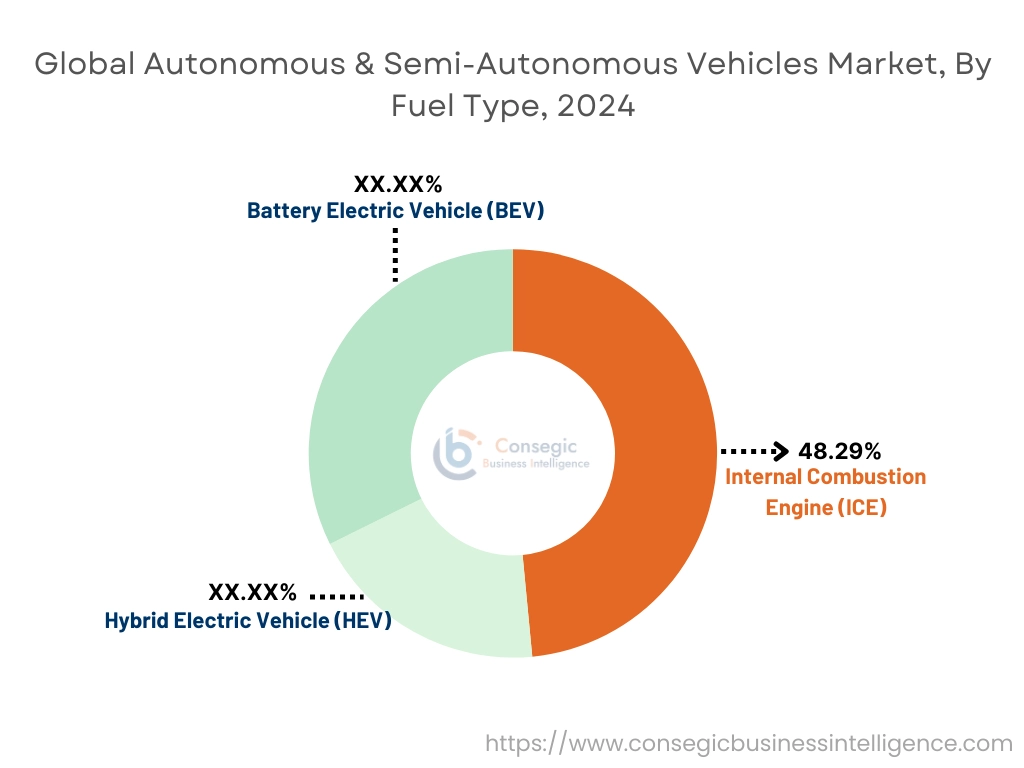
By Technology:
Based on the technology, the market is segmented into adaptive cruise control, lane keep assist, intelligent park assist, blind spot detection, emergency brake assist, and adaptive front lighting.
Trends in the technology:
- There is a rising trend towards the integration of adaptive cruise control system in modern vehicles to facilitate improved speed control, lower chances of collisions, and improved comfort while driving among others.
- Rising advancements associated with blind spot detection solution for decreasing the risk of accidents, particularly during lane changes by monitoring the dangerous blind spot area and improving vehicle safety.
Adaptive cruise control segment accounted for the largest revenue share in the total autonomous & semi-autonomous vehicles market share in 2024.
- Adaptive cruise control (ACC) refers to a type of system for road vehicles that is capable of automatically adjusting the vehicle's speed to maintain a safe distance from vehicles ahead.
- Adaptive cruise control enables users to relax while driving, particularly on highways, by automatically adjusting the car’s speed by matching the speed of the vehicles in front.
- Moreover, adaptive cruise control provides several benefits such as improved speed control, enhanced comfort while driving, lower chances of collisions, and others.
- For instance, Robert Bosch offers adaptive cruise control (ACC) solutions in its product offerings. The ACC solutions is designed for integration in passenger cars.
- According to the analysis, the rising advancements associated with adaptive cruise control solutions are propelling the autonomous & semi-autonomous vehicles market trends.
Blind spot detection segment is anticipated to register substantial CAGR growth during the forecast period.
- A blind spot detection system includes a vehicle-based sensor device that is capable of detecting other vehicles to the side and rear of the driver. The warning may be audible, visual, vibrating, or tactile.
- Moreover, blind spot detection system helps in reducing the risk of accidents during lane changes by monitoring the dangerous blind spot area.
- For instance, in October 2023, Sensata Technologies launched its new PreView Sentry 79 model of take-off and reverse blind spot monitoring radar. The blind spot monitoring radar is developed to set a new standard for blind spot detection and collision avoidance in the automotive sector.
- Thus, the increasing innovations related to with automotive blind spot detection solutions are anticipated to boost the market during the forecast period.
Regional Analysis:
The regions covered are North America, Europe, Asia Pacific, Middle East and Africa, and Latin America.
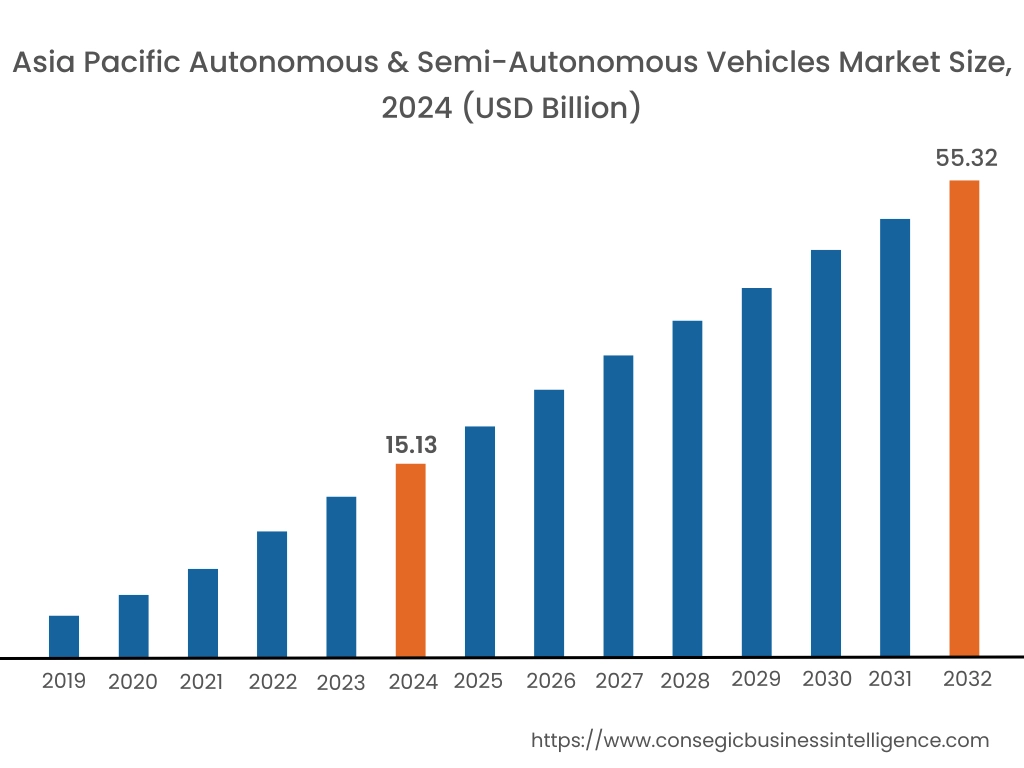
Asia Pacific region was valued at USD 15.13 Billion in 2024. Moreover, it is projected to grow by USD 17.50 Billion in 2025 and reach over USD 55.32 Billion by 2032. Out of this, China accounted for the maximum revenue share of 33.93%. As per the autonomous & semi-autonomous vehicles market analysis, the adoption of semi-autonomous & autonomous vehicles in the Asia-Pacific region is primarily driven by rising government investments in automotive industry, increasing automobile production, and growing advancements in automotive technologies among others. Additionally, increasing advancements associated with autonomous vehicles and rising integration of advanced driver assistance system in modern vehicles are further accelerating the autonomous & semi-autonomous vehicles market expansion.
- For instance, in 2024, BYD, a China-based automobile manufacturer, launched a two new electric vehicles, featuring a driving range of 545km and 634km. Both vehicles are integrated with preliminary self-driving/autonomous software and a digital cockpit. The above factors are boosting the market demand in the Asia-Pacific region.
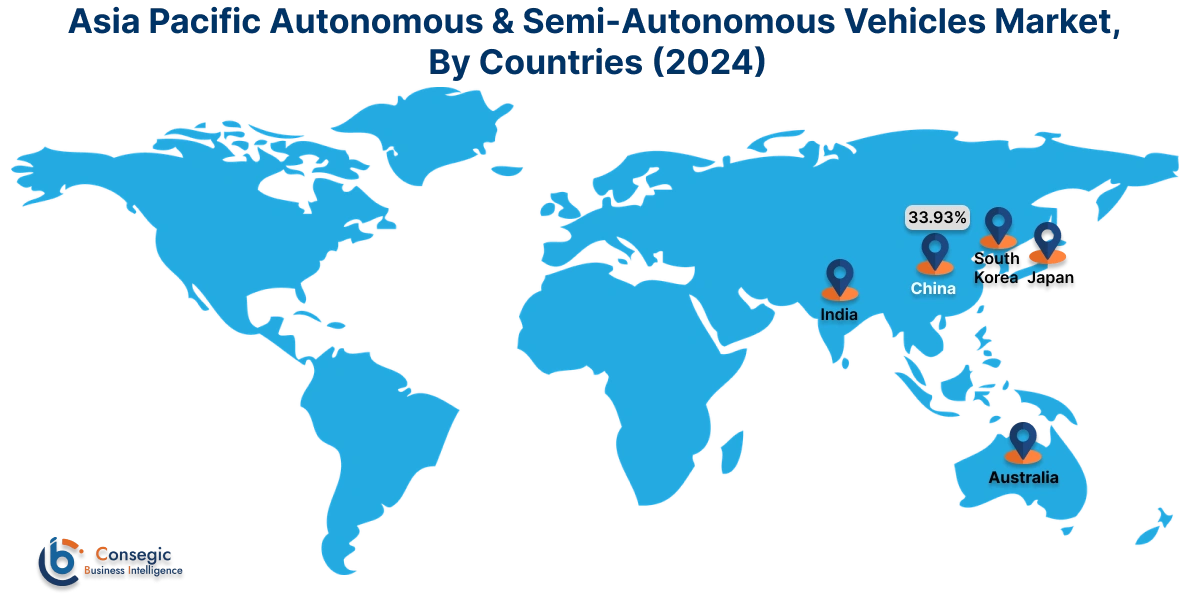
North America is estimated to reach over USD 79.06 Billion by 2032 from a value of USD 22.54 Billion in 2024 and is projected to grow by USD 25.98 Billion in 2025. In North America, the growth of autonomous & semi-autonomous vehicles industry is driven by rising production of automobiles and increasing technological advancements in the region. Similarly, rising advancements associated with autonomous driving are further contributing to the autonomous & semi-autonomous vehicles market demand.
- For instance, in October 2024, Tesla introduced the Cybercab, the company’s robotaxi, and also announced plans to commence autonomous driving of its Model 3 and Model Y cars in Texas and California states in the U.S in 2025. The above factors are projected to boost the market demand in North America during the forecast period.
Additionally, the regional analysis depicts that the advent of electro mobility, increasing electric vehicle production, and advancements in self-driving vehicles are propelling the autonomous & semi-autonomous vehicles market demand in Europe. Furthermore, as per the market analysis, the market demand in Latin America, Middle East, and African regions is expected to grow at a considerable rate due to factors such as growing automotive sector and increasing investments in automobile technologies among others.
Top Key Players and Market Share Insights:
The global autonomous & semi-autonomous vehicles market is highly competitive with major players providing products to the national and international markets. Key players are adopting several strategies in research and development (R&D), product innovation, and end-user launches to hold a strong position in the autonomous & semi-autonomous vehicles market. Key players in the autonomous & semi-autonomous vehicles industry include-
- Tesla (U.S)
- General Motors (U.S)
- Volvo Car Corporation (Germany)
- Waymo LLC (U.S)
- Nissan Motor Co. Ltd. (Japan)
- Volkswagen AG (Germany)
- Aptiv (Ireland)
- Hyundai Motor Company (South Korea)
- Mobileye (Israel)
- Nuro (U.S)
- Aurora Innovation (U.S)
- Valeo (France)
Recent Industry Developments :
Product Launch:
- In March 2025, Waymo announced plans to launch robotaxi in Washington, U.S in 2026. Waymo currently operates its driverless/autonomous ride hailing vehicles in Los Angeles, San Francisco, and Phoenix cities.
Partnerships and Collaborations:
- In September 2023, Valeo and Mobileye announced a new partnership for delivering imaging radars for facilitating next-generation advanced driver assist and automated driving features.
Autonomous & Semi-Autonomous Vehicles Market Report Insights :
| Report Attributes | Report Details |
| Study Timeline | 2019-2032 |
| Market Size in 2032 | USD 212.69 Billion |
| CAGR (2025-2032) | 19.1% |
| By Level of Automation |
|
| By Component |
|
| By Fuel Type |
|
| By Technology |
|
| By Region |
|
| Key Players |
|
| North America | U.S. Canada Mexico |
| Europe | U.K. Germany France Spain Italy Russia Benelux Rest of Europe |
| APAC | China South Korea Japan India Australia ASEAN Rest of Asia-Pacific |
| Middle East and Africa | GCC Turkey South Africa Rest of MEA |
| LATAM | Brazil Argentina Chile Rest of LATAM |
| Report Coverage |
|
Key Questions Answered in the Report
How big is the autonomous & semi-autonomous vehicles market? +
The autonomous & semi-autonomous vehicles market was valued at USD 60.22 Billion in 2024 and is projected to grow to USD 212.69 Billion by 2032.
Which is the fastest-growing region in the autonomous & semi-autonomous vehicles market? +
Asia-Pacific is the region experiencing the most rapid growth in the autonomous & semi-autonomous vehicles market.
What specific segmentation details are covered in the autonomous & semi-autonomous vehicles report? +
The autonomous & semi-autonomous vehicles report includes specific segmentation details for level of automation, component, fuel type, technology, and region.
Who are the major players in the autonomous & semi-autonomous vehicles market? +
The key participants in the autonomous & semi-autonomous vehicles market are Tesla Inc. (U.S), General Motors (U.S), Aptiv (Ireland), Hyundai Motor Company (South Korea), Mobileye (Israel), Nuro (U.S), Aurora Innovation (U.S), Valeo (France), Volvo Car Corporation (Germany), Waymo LLC (U.S), Nissan Motor Co. Ltd. (Japan), Volkswagen AG (Germany), and others.
